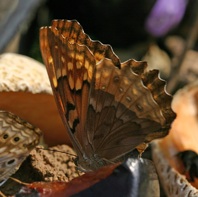Basics of Bugging

Butterfly Feeders
Wednesday, June 15, 2011

Most butterflies feed on nectar. For these butterflies, simply providing the right nectar plants, including natives such as asters, milkweeds, coneflowers, and blue mist flower, and exotics such as butterfly bush, zinnias, and marigolds, will provide them with the food they need. Other butterflies feed on sap or rotten fruit.
The picture above shows 3 mourning cloaks, a gray comma, and an eastern comma getting sap from a tree stump in spring. These are some of the species that can be attracted using a butterfly feeder.
How to Make a Feeder
Making a feeder couldn’t be easier. Basically, all you need is something to hold the fruit. You can go simple and just use a plate or pie tin, or you can get fancier and make a hanging feeder with a bottom that drains. The butterflies really won’t care. The hanging feeder is probably the most flexible design: make a frame out of 1”x1” wood; I suggest keeping it to approximately 1 ft square to keep the weight down. Staple or tack window screening to the bottom of the frame. To hang the feeder, use some screw eyes in each corner of the frame and attach wire or string to the screw eyes. Bring the four strings together and form a single connection point that you can hang from a shepherd’s crook or similar structure. That’s it! Obviously, you can spruce up this basic design to make something that’s prettier for people, but as I said earlier - the butterflies won’t care. They’re in it for the sugar, not the aesthetics.
What Kind of Food to Use
Many types of fruit will work. We’ve used melon (watermelon, cantaloupe, and honeydew), banana, apple, orange, and mango. The butterflies will like it best if it’s overripe, so this is a great way to use rotten fruit or rinds from fruit you’ve eaten.
Where to Locate the Feeder
Butterflies like the sun and don’t like the wind, so try to place your feeder in that type of location. If you can, put the feeder someplace where you can easily see it from your house or office so you can keep track of the butterflies. If they are in the area and hungry, the butterflies will be able to find the feeder by scent. Simply replace the fruit when it has dried out or become too moldy.
What will you attract?
The primary fruit feeders in the U.S.A. are some of the butterflies in the brush-foot family (Nymphalidae). In our area, these butterflies include the anglewings (commas and question marks), the emperors (hackberry and tawny), the viceroy, orange-spotted purple, red admiral, and mourning cloak. During really dry periods, we’ve had other butterflies at our feeder, including those that normally feed at flowers (such as the painted lady).
Keep in mind that many of these butterflies are typically found in forests or forest edges, and so if you don’t have these habitats around, you may not be able to attract these butterflies (it’s hard to attract something that isn’t there to start with!). Also, butterfly feeding seems to work best in early spring and in fall (perhaps because flowing sap and rotten fruit are found naturally in those seasons?).
Hackberry emperor Tawny emperor
Eastern comma Question mark
Question mark Gray comma
The only problems with feeders arise from the other animals that want the fruit. In the fall, yellowjacket wasps and bald-faced hornets also enjoy fruit, and sometimes they try to claim the fruit as theirs by chasing the butterflies. They won’t try to sting you if you don’t bother them (or maybe even if you do) because this is a feeding site and not their nest, but you should still be careful, especially if you have or might have an allergy to stings. At all times, ants and fruit-eating mammals like raccoons could help themselves. I’ve found the best way to deal with these other hungry animals is to try to hang it so the mammals don’t get it (I haven’t had trouble with a shepherd’s crook) and let the other insects help themselves.
Some butterflies, especially some of the brush-footed butterflies (nymphalids) feed on sugary/yeasty foods like sap and rotting fruit. If they are in the area, these butterflies will will come into feeders if you provide the right food.








